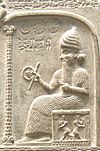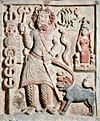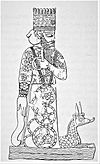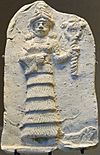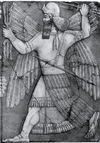Babylonian Gods facts for kids
Babylonian religion was greatly influenced by Sumerian religion, so many Babylonian gods were just old Sumerian gods under the same or new names.
Babylonia mainly focused on the god Marduk, who is the national god of the Babylonian empire. He was one of the "new" Mesopotamian Gods that Sumers did not have before. However, there were also other gods that were worshipped.
Major gods were associated with specific celestial bodies.
The modern seven-day week originated with the ancient Babylonians, for whom each day was associated with one of the seven planetary gods.
Main Babylonian Gods
| God name(s) | Image | Celestial body | Details | Associated metal and color |
|---|---|---|---|---|
| Utu Shamash |
Sun | Utu, later known as Shamash, is the ancient Mesopotamian god of the Sun, who was also revered as the god of truth, justice, and morality. The Sun-god was believed to see all things that happen during the day and to aid mortals in distress. Alongside his sister Inanna, Utu was the enforcer of divine justice. | Gold, yellow | |
| Nanna-Suen Nanna, Enzu, Zuen, Suen, Sin |
Moon | Nanna, Enzu or Zuen ("Lord of Wisdom") in Sumerian, later altered as Suen and Sin in Akkadian, is the ancient Mesopotamian god of the Moon. The Moon-god has an important role among the major gods - he is regarded as symbolizing the pleroma (the sum of all the gods' powers). The crescent of the Moon-god was featured on the top of the cusps of Mesopotamian temples. | Silver, green | |
| Nergal | Mars | Nergal was associated with the Underworld. He was also associated with forest fires (and identified with the fire-god, Gibil), fevers, plagues, and war. In myths, he causes destruction and devastation. | Iron, red | |
| Nabu | Mercury | Nabu was the Mesopotamian god of scribes and writing. His wife was the goddess Tashmetu and he was associated with the planet Mercury. He later became associated with wisdom and agriculture. | Mercury, orange | |
| Marduk | Jupiter | Marduk is the national god of the Babylonians. The expansion of his cult followed the historical rise of Babylon, and he eventually became the chief Babylonian god. His wife was the goddess Sarpānītu. | Tin, white | |
| Inanna Ishtar |
Venus | Inanna, later known as Ishtar, is the most important female deity of ancient Mesopotamia. She was the goddess of love, and war. She was the divine personification of the planet Venus. Ancient Sumerians had more myths about her than any other deity. Alongside her twin brother Utu, Inanna was the enforcer of divine justice. | Copper, blue | |
| Ninurta Ninĝirsu |
Saturn | Ninurta, also known as Ningirsu, was a Mesopotamian warrior deity who was worshipped in Sumer from the very earliest times. Ninurta was a god of war and hunting. He was also an agricultural deity and the patron god of farmers. In the epic poem Lugal-e, he slays the demon Asag and uses stones to build the Tigris and Euphrates rivers to make them useful for irrigation. His major symbols were a perched bird and a plow. | Lead, black |
Related pages
Images for kids

All content from Kiddle encyclopedia articles (including the article images and facts) can be freely used under Attribution-ShareAlike license, unless stated otherwise. Cite this article:
Babylonian Gods Facts for Kids. Kiddle Encyclopedia.

